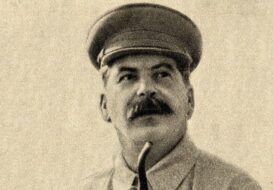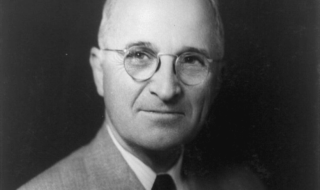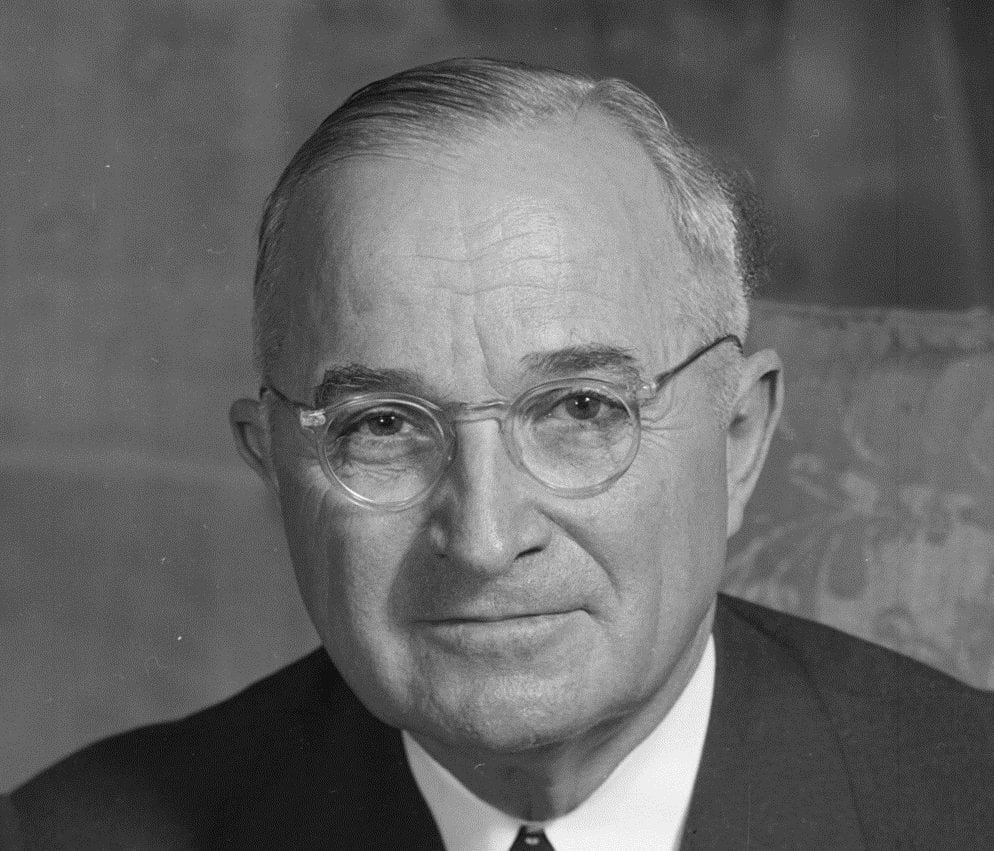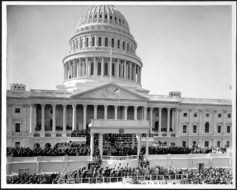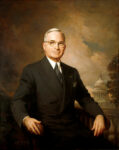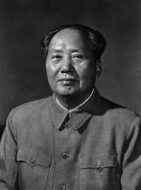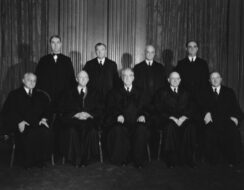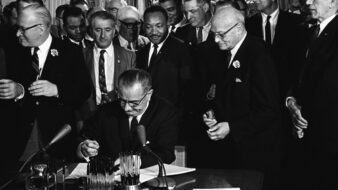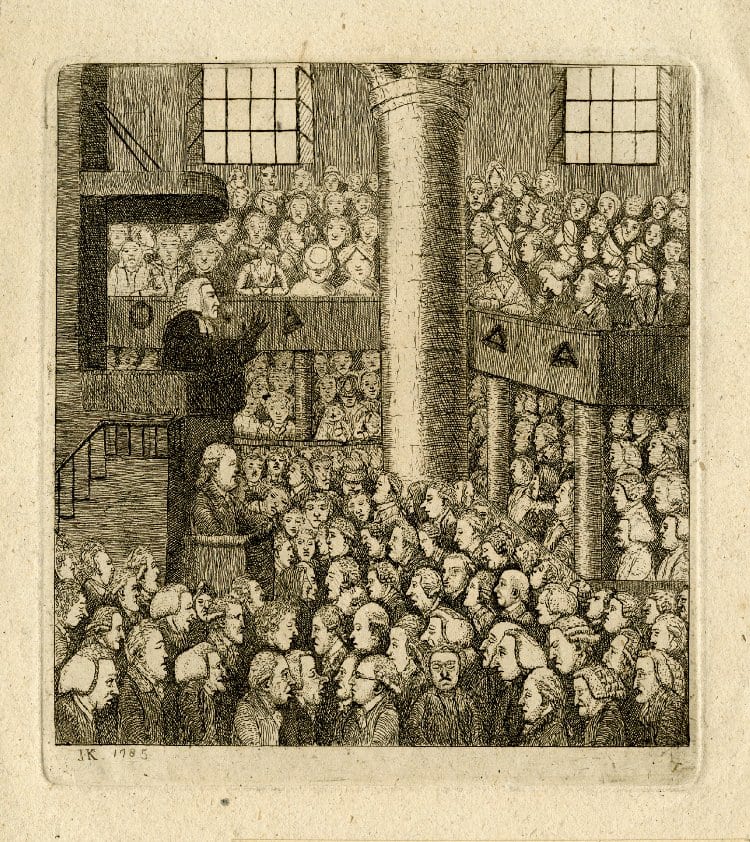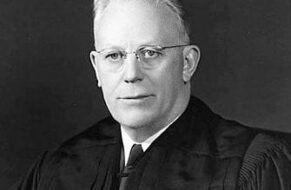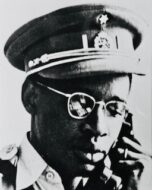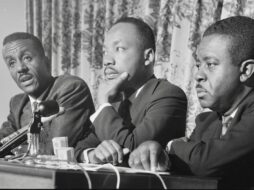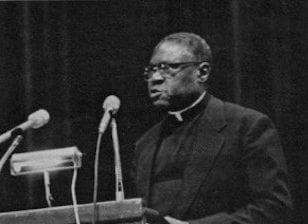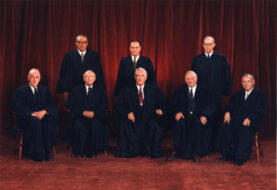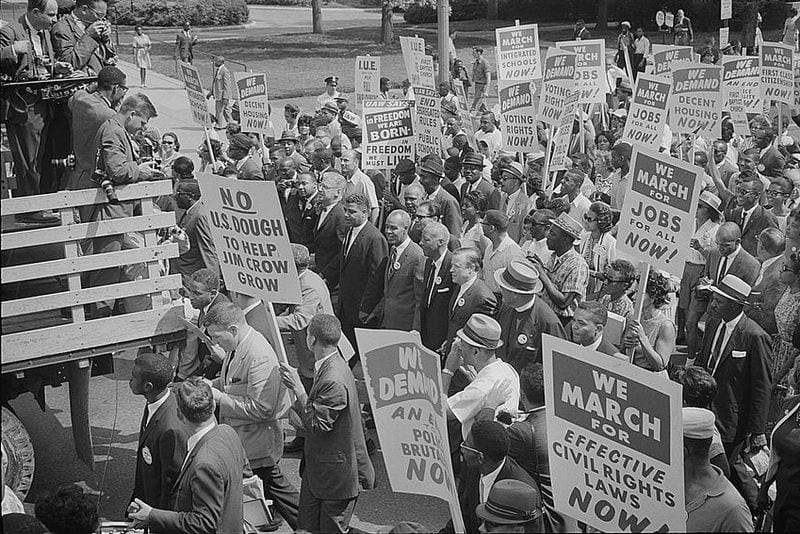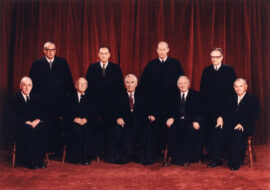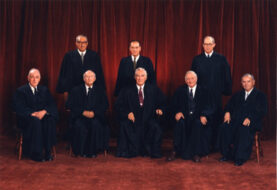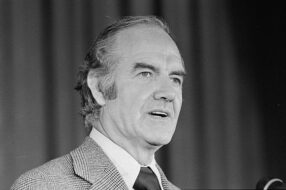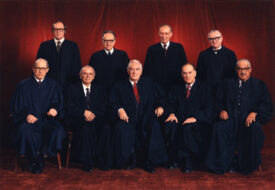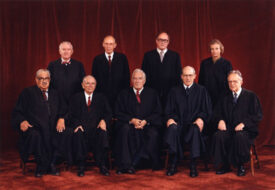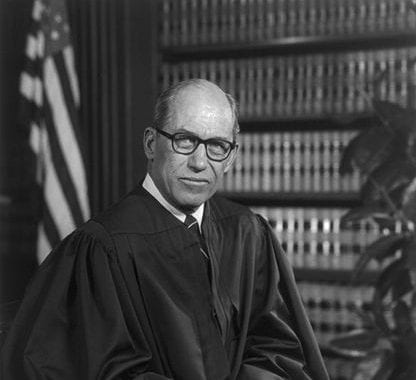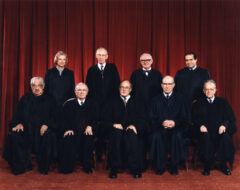


Introduction
Daniel Patrick Moynihan (1927–2003) was an academic, politician, and diplomat. He served in the Senate as a Democrat representing New York from 1977 to 2001. In 1965, he was an Assistant Secretary of Labor in the Johnson Administration. His primary responsibility was to assist in planning the “war on poverty” that President Johnson had declared in 1964. Noticing the rising numbers of African American women on welfare, even as the number of employed African American men increased, Moynihan wondered why this was so. Typically, prior to the early 1960s, male employment and female welfare participation had moved in tandem: the black female welfare rate decreased when black male employment increased. Moynihan concluded that the cause of rising welfare participation was the increasing number of African American women who had children but were not married. This lack of stable two-parent families—even as more and more African Americans reached the middle class—led, Moynihan concluded, to what he called the “tangle of pathologies” adversely affecting poor African Americans. (Moynihan borrowed the phrase from psychologist Kenneth Clark.)
Moynihan’s report was controversial. The phrase “blaming the victim” was coined to describe it, because it was felt to blame the behavior of African Americans, rather than the prejudice of whites, for the problems among African Americans. Other critics wondered if single parent families caused poverty or if poverty caused single parent families. Feminists objected to Moynihan’s emphasis on the patriarchal family. Some critics claimed Moynihan failed to recognize sources of strength in the African American family. A critic might also object to Moynihan’s method. As he acknowledged, his report did not examine the Black middle class. This prevented him from considering why so many African Americans (he estimated at least half) avoided the pathologies he described, even though all African Americans suffered from the same disabilities he identified: the heritage of slavery, rapid urbanization, ongoing prejudice, and historically higher rates of unemployment and poverty. It is also worth noting that the scholarship upon which Moynihan based his report is now out of date in many respects. In particular, scholars now credit slaves with more agency, more control over their lives and circumstances, than earlier scholars did.
Apart from the details of its argument, Moynihan’s report is important because it pointed to “a new period” in the civil rights movement. The Civil Rights Act of 1964 had put an end to legal segregation, creating legal equality of opportunity. What was next? One answer came in Moynihan’s support not just for equality of opportunity, but for equality of results. This position received official sanction a few months later, when Moynihan’s arguments informed a speech by President Johnson. After Moynihan’s report circulated among officials in the Johnson administration, he was asked to draft Johnson’s speech.
Readers should be aware that in discussing race relations during Reconstruction, Moynihan used a derogatory term for African Americans.
Source: The Negro Family: The Case for National Action (Washington, DC: The Office of Policy Planning and Research, U.S. Department of Labor, March 1965).
The United States is approaching a new crisis in race relations.
In the decade that began with the school desegregation decision of the Supreme Court,[1] and ended with the passage of the Civil Rights Act of 1964, the demand of Negro Americans for full recognition of their civil rights was finally met. . .
In this new period the expectations of the Negro Americans will go beyond civil rights. Being Americans, they will now expect that in the near future equal opportunities for them as a group will produce roughly equal results, as compared with other groups. This is not going to happen. Nor will it happen for generations to come unless a new and special effort is made.
There are two reasons. First, the racist virus in the American blood stream still afflicts us: Negroes will encounter serious personal prejudice for at least another generation. Second, three centuries of sometimes unimaginable mistreatment have taken their toll on the Negro people.
The harsh fact is that as a group, at the present time, in terms of ability to win out in the competitions of American life, they are not equal to most of those groups with which they will be competing. Individually, Negro Americans reach the highest peaks of achievement. But collectively, in the spectrum of American ethnic and religious and regional groups, where some get plenty and some get none, where some send eighty percent of their children to college and others pull them out of school at the 8th grade, Negroes are among the weakest.
The most difficult fact for white Americans to understand is that in these terms the circumstances of the Negro American community in recent years has probably been getting worse, not better. Indices of dollars of income, standards of living, and years of education deceive.[2] The gap between the Negro and most other groups in American society is widening.
The fundamental problem, in which this is most clearly the case, is that of family structure. The evidence—not final, but powerfully persuasive—is that the Negro family in the urban ghettos is crumbling. A middle-class group has managed to save itself, but for vast numbers of the unskilled, poorly educated city working class the fabric of conventional social relationships has all but disintegrated. There are indications that the situation may have been arrested in the past few years, but the general post-war trend is unmistakable. So long as this situation persists, the cycle of poverty and disadvantage will continue to repeat itself.
The thesis of this paper is that these events, in combination, confront the nation with a new kind of problem. Measures that have worked in the past, or would work for most groups in the present, will not work here. A national effort is required that will give a unity of purpose to the many activities of the Federal government in this area, directed to a new kind of national goal: the establishment of a stable Negro family structure. . . .
Chapter 1
The End of the Beginning
The major events of the onset of the Negro revolution are now behind us.
The political events were three: First, the Negroes themselves organized as a mass movement. Their organizations have been in some ways better disciplined and better led than any in our history. They have established an unprecedented alliance with religious groups throughout the nation and have maintained close ties with both political parties and with most segments of the trade union movement. Second, the Kennedy-Johnson Administration committed the Federal government to the cause of Negro equality. This had never happened before. Third, the 1964 Presidential election was practically a referendum on this commitment: if these were terms made by the opposition, they were in effect accepted by the President.[3]
. . . [T]he Civil Rights Act of 1964[4] marked the end of the era of legal and formal discrimination against Negroes and created important new machinery for combating covert discrimination and unequal treatment. (The Act does not guarantee an end to harassment in matters such as voter registration, but does make it more or less incumbent upon government to take further steps to thwart such efforts when they do occur.)[5] . . .
The Demand for Equality
The ideal of equality does not ordain that all persons end up, as well as start out equal. . . . But the evolution of American politics, with the distinct persistence of ethnic and religious groups, has added a profoundly significant new dimension to that egalitarian ideal. It is increasingly demanded that the distribution of success and failure within one group be roughly comparable to that within other groups. It is not enough that all individuals start out on even terms, if the members of one group almost invariably end up well to the fore, and those of another far to the rear. This is what ethnic politics are all about in America, and in the main the Negro American demands are being put forth in this now traditional and established framework. . . .
The principal challenge of the next phase of the Negro revolution is to make certain that equality of results will now follow. If we do not, there will be no social peace in the United States for generations.
The Prospect for Equality
The time, therefore, is at hand for an unflinching look at the present potential of Negro Americans to move from where they now are to where they want, and ought to be. . . .
Chapter 2
The Negro American Family
At the heart of the deterioration of the fabric of Negro society is the deterioration of the Negro family.[6] . . .
There is probably no single fact of Negro American life so little understood by whites. The Negro situation is commonly perceived by whites in terms of the visible manifestations of discrimination and poverty, in part because Negro protest is directed against such obstacles, and in part, no doubt, because these are facts which involve the actions and attitudes of the white community as well. It is more difficult, however, for whites to perceive the effect that three centuries of exploitation have had on the fabric of Negro society itself. Here the consequences of the historic injustices done to Negro Americans are silent and hidden from view. But here is where the true injury has occurred: unless this damage is repaired, all the effort to end discrimination and poverty and injustice will come to little.
The role of the family in shaping character and ability is so pervasive as to be easily overlooked. The family is the basic social unit of American life; it is the basic socializing unit. By and large, adult conduct in society is learned as a child. . . .
The white family has achieved a high degree of stability and is maintaining that stability.
By contrast, the family structure of lower-class Negroes is highly unstable, and in many urban centers is approaching complete breakdown.
- B.[7] There is considerable evidence that the Negro community is in fact dividing between a stable middle-class group that is steadily growing stronger and more successful, and an increasingly disorganized and disadvantaged lower-class group. There are indications, for example, that the middle-class Negro family puts a higher premium on family stability and the conserving of family resources than does the white middle-class family. The discussion of this paper is not, obviously, directed to the first group. . . .
. . . [T]he emergence and increasing visibility of a Negro middle-class may beguile the nation into supposing that the circumstances of the remainder of the Negro community are equally prosperous, whereas just the opposite is true at present, and is likely to continue so. . . .
Nearly a quarter of urban negro marriages are dissolved . . . .
Nearly one-quarter of negro births are now illegitimate. . . . .
Almost one-fourth of negro families are headed by females. . . .
The breakdown of the negro family has led to a startling increase in welfare dependency. . . . The steady expansion of this welfare program, as of public assistance programs in general, can be taken as a measure of the steady disintegration of the Negro family structure over the past generation in the United States.
Chapter 3
The Roots of the Problem
Slavery
The most perplexing question about American slavery; which has never been altogether explained, and which indeed most Americans hardly know exists, has been stated by Nathan Glazer as follows: “Why was American slavery the most awful the world has ever known.”[8] The only thing that can be said with certainty is that this is true: it was. . . .
“. . . American slavery was also awful in its effects. If we compared the present situation of the American Negro with that of, let us say, Brazilian Negroes (who were slaves 20 years longer), we begin to suspect that the differences are the result of very different patterns of slavery. Today the Brazilian Negroes are Brazilians; though most are poor and do the hard and dirty work of the country, as Negroes do in the United States, they are not cut off from society. They reach into its highest strata, merging there—in smaller and smaller numbers, it is true, but with complete acceptance—with other Brazilians of all kinds. The relations between Negroes and whites in Brazil show nothing of the mass irrationality that prevails in this country[9] .” . . .
The Reconstruction
With the emancipation of the slaves, the Negro American family began to form in the United States on a widespread scale. But it did so in an atmosphere markedly different from that which has produced the white American family.
The Negro was given liberty, but not equality. Life remained hazardous and marginal. Of the greatest importance, the Negro male, particularly in the South, became an object of intense hostility, an attitude unquestionably based in some measure on fear.
When Jim Crow made its appearance towards the end of the 19th century,[10] it may be speculated that it was the Negro male who was most humiliated thereby; the male was more likely to use public facilities, which rapidly became segregated once the process began, and just as important, segregation, and the submissiveness it exacts, is surely more destructive to the male than to the female personality. Keeping the Negro “in his place” can be translated as keeping the Negro male in his place: the female was not a threat to anyone.
Unquestionably, these events worked against the emergence of a strong father figure. The very essence of the male animal, from the bantam rooster to the four-star general, is to strut. Indeed, in 19th century America, a particular type of exaggerated male boastfulness became almost a national style. Not for the Negro male: The “sassy nigger” was lynched.
In this situation, the Negro family made but little progress toward the middle-class pattern of the present time. Margaret Mead has pointed out that while “In every known human society, everywhere in the world, the young male learns that when he grows up one of the things which he must do in order to be a full member of society is to provide food for some female and her young.”[11] . . .
“Within the family, each new generation of young males learn the appropriate nurturing behavior and superimpose upon their biologically given maleness this learned parental role. When the family breaks down . . . this delicate line of transmission is broken. Men may flounder badly in these periods, during which the primary unit may again become mother and child, the biologically given, and the special conditions under which man has held his social traditions in trust are violated and distorted.”[12] . . .
Urbanization
Country life and city life are profoundly different. The gradual shift of American society from a rural to an urban basis over the past century and a half has caused abundant strains, many of which are still much in evidence. When this shift occurs suddenly, drastically, in one or two generations, the effect is immensely disruptive of traditional social patterns.
It was this abrupt transition that produced the wild Irish slums of the 19th Century Northeast; drunkenness, crime, corruption, discrimination, family disorganization, juvenile delinquency were the routine of that era. In our own time, the same sudden transition has produced the Negro slum—different from, but hardly better than its predecessors, and fundamentally the result of the same process.
Negroes are now more urbanized than Whites. . . .
Negro families in the cities are more frequently headed by a woman than those in the country. The difference between the white and Negro proportions of families headed by a woman is greater in the city than in the country. . . .
In every index of family pathology—divorce, separation, and desertion, female family head, children in broken homes, and illegitimacy—the contrast between the urban and rural environment for Negro families is unmistakable. . . .
Unemployment and Poverty
. . .
The fundamental, overwhelming fact is that Negro unemployment, with the exception of a few years during World War II and the Korean War, has continued at disaster levels for 35 years . . . .
The conclusion from these and similar data is difficult to avoid: During times when jobs were reasonably plentiful . . . the Negro family became stronger and more stable. As jobs became more and more difficult to find, the stability of the family became more and more difficult to maintain. . . .
Chapter 4
The Tangle of Pathology
. . .
Obviously, not every instance of social pathology afflicting the Negro community can be traced to the weakness of family structure. . . . Nonetheless, at the center of the tangle of pathology is the weakness of the family structure. Once or twice removed, it will be found to be the principal source of most of the aberrant, inadequate, or antisocial behavior that did not establish, but now serves to perpetuate the cycle of poverty and deprivation. . . .
The combined impact of poverty, failure, and isolation among Negro youth has had the predictable outcome in a disastrous delinquency and crime rate. . . .
The term alienation may by now have been used in too many ways to retain a clear meaning, but it will serve to sum up the equally numerous ways in which large numbers of Negro youth appear to be withdrawing from American society. . . .
. . . [T]he official unemployment rates for Negroes are almost unbelievable. . . .
Narcotic addiction is a characteristic form of withdrawal. In 1963, Negroes made up 54 percent of the addict population of the United States. . . .
There is a larger fact about the alienation of Negro youth than the tangle of pathology described by these statistics. . . .
Until World War II it could be said that in general the Negro and white worlds lived, if not together, at least side by side. Certainly they did, and do, in the South.
Since World War II, however, the two worlds have drawn physically apart. The symbol of this development was the construction in the 1940’s and 1950’s of the vast white, middle- and lower-middle class suburbs around all of the Nation’s cities. Increasingly, the inner cities have been left to Negroes—who now share almost no community life with whites.
In turn, because of this new housing pattern—most of which has been financially assisted by the Federal government[13]—it is probable that the American school system has become more, rather than less segregated in the past two decades. . . .
Chapter 5
The Case for National Action
. . .
What then is [the] problem? We feel the answer is clear enough. Three centuries of injustice have brought about deep-seated structural distortions in the life of the Negro American. At this point, the present tangle of pathology is capable of perpetuating itself without assistance from the white world. The cycle can be broken only if these distortions are set right. . . .
. . . The President has committed the nation to an all-out effort to eliminate poverty wherever it exists, among whites or Negroes, and a militant, organized, and responsible Negro movement exists to join in that effort.
Such a national effort could be stated thus:
The policy of the United States is to bring the Negro American to full and equal sharing in the responsibilities and rewards of citizenship. To this end, the programs of the Federal government bearing on this objective shall be designed to have the effect, directly or indirectly, of enhancing the stability and resources of the Negro American family.
- 1. Brown v. Board of Education.
- 2. All of these indices had been going up among African Americans during the 1950s and early 1960s.
- 3. Johnson won a landslide victory over Barry Goldwater in 1964.
- 4. The Civil Rights Act, 1964.
- 5. The Voting Rights Act (1965) addressed this issue.
- 6. Since the end of slavery, African Americans appear to have had a higher incidence of single (female) parent families than whites. From 1880 to 1960, however, the rate of single parent African American families was stable. From 1960, it increased sharply.
- 7. Note Bene, Latin for note well.
- 8. Moynihan’s footnote: Nathan Glazer, “Introduction,” in Slavery, by Stanley M. Elkins (New York, Grosset and Dunlap, 1963), p. ix. Nathan Glazer (1923–2019) was a sociologist.
- 9. Moynihan’s footnote: Glazer, “Introduction,” pp. ix-x.
- 10. The system of legal segregation in the south that prevailed from the 1890s to the 1960s. See Document 29.
- 11. Moynihan’s footnote: Margaret Mead, Male and Female, (New York, New American Library, 1962), p. 146.
- 12. Moynihan’s footnote: Mead, Male and Female, p. 146.
- 13. In providing financial support, the federal government advocated the maintenance of “harmonious” neighborhoods. This permitted real estate practices that discriminated against African Americans, resulting in their exclusion from certain residential areas. See Document 32.

Conversation-based seminars for collegial PD, one-day and multi-day seminars, graduate credit seminars (MA degree), online and in-person.




